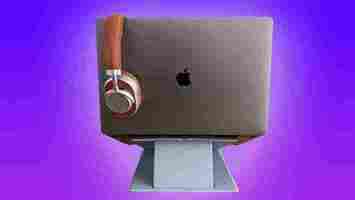Working from home? Get yourself a laptop stand and thank me later
Let me lay it out simply: If you’re working from home during the coronavirus lockdown, you should get a laptop stand. Honestly. Your body will thank you.

Anyway, onto my deeply, deeply uninspiring journey.
Here at TNW we were asked to work from home in the middle of March. Now, one of the great things about working here is our flexible remote working policy. When the lockdown happened, I didn’t think my work life would change that much. I mean, I write at home constantly, how different could it be?
Then my body betrayed me.
About a week and half into lockdown I noticed my neck hurt. I woke up feeling like I’d slept on the floor, my upper back muscles ached and creaked. Basically, I felt like I’d been bunched up into a sea shell and been given a bit of a kicking.
I stretched it out, I did some yoga, but that didn’t really help. Eventually I worked out what was wrong: In the office I have an external monitor lifted up to eye-level, at home I spend all day hunched over my laptop like some sort of digital neanderthal. I wasn’t as equipped as I thought. I needed a laptop stand.
Blessedly, I was semi-prepared.
Ahead of the lockdown I brought a selection of gadgets back with me to review, and I was in luck: Someone had just sent me the Moft Z laptop stand to check out and, on a whim, I’d decided to bring it home. And thank fuck I did.


Basically, the Moft Z laptop stand is this magazine-sized bit of hardware that folds out in different ways. It can function as a standing desk, or prop up your computer at a variety of angles to make it easier to use. And when you’re done? It folds neatly away into something you can easily tuck into your back or put on a shelf.
It’s a pretty nifty bit of kit, but not something I’d necessarily be particularly excited about in normal circumstances. However, with the coronavirus lockdown it’s become an essential part of my working day. And my spine and neck is thankful for this change.
If you want one, you can check out their website here . But, at this point, I’d just suggest getting your hands on anything — something you can do by having a gander on Amazon .
Of course, going on Amazon may not be to everyone’s taste ( something I can’t disagree with ), so there is a way around it. Put your laptop on some books, or a cereal box — really anything that’ll help raise the thing from your working surface and bring it roughly eye-level.
Will an actual laptop stand be better? Yeah, of course, but the goal here is to not mash up your body and make working from home a bit more comfortable. As long as you manage that, you’ll be okay.
How to sell a product without twisting your customer’s arm
So you like our media brand Growth Quarters? You should join our Growth Quarters event track at TNW2020 , where you’ll hear how the most successful founders kickstarted and grew their companies.

This article was originally published by Built In .
Why do some new products fly off the shelves while others have sales cycles that extend out for months?
Selling any product is a mixture of art and science, but selling a new product with no track record from a company with no reputation — that requires a science all its own.
Every new product is different, of course, but one commonality I see among successful startups is an unwillingness to market and sell to people who aren’t buying. As simple as that sounds, it’s a trap entrepreneurs fall into over and over again.
In 20 years of rolling out new products and selling into dozens of different markets, I’ve learned that, to sell a new product, repeatedly and sustainably, you have to refuse to twist the customer’s arm.
Here’s how to do that.
Your goal is not to sell as much product as you can
I’m going to buck conventional wisdom here a little bit and tell you that all of the advice you hear about always-be-selling and always-be-closing and throwing enough shit at a wall for some to stick — this isn’t for you.
I’m not disparaging those tactics, per se, just letting you know they’re not intended for an entrepreneur selling a new product.
They say that every buying decision is made almost immediately; some will even peg that limit at the first 60 seconds. One of the reasons a lot of entrepreneurs hate selling is because they think that those 60 seconds have something to do with them. They do not. Those 60 seconds are all about the product and the pitch.
In fact, confident salespeople might tell you they exude confidence because they’re great at selling. But in their darkest hours, they’ll admit that their confidence comes from having a great product, an amazing message, and selling into the right market.
Those first two things are far easier to change than that last one. So let’s start with the hardest part first.
Discover your market
Who would buy this?
That’s a question you should be asking from the moment your startup idea pops into your brain. I can’t tell you how many fully developed products get put in front of me with fully formed marketing materials, and I have no idea who would buy the product and why.
And when I ask, the answer I usually get is: “Anyone!” or some slight derivation. That answer could be correct, but it requires twisting an awful lot of arms.
A startup finds product-market fit by either adjusting the product to meet the market or by moving to a new market, one that finds more value in the product. The latter is risky, because the problem/solution equation usually lies within a specific market. Move away from that market, and the problem is likely not as painful, and the solution is probably not as valuable.
So every decision you make during the first X months of the life of your product should be rooted in that question: Who would buy this?
Will your decision widen your market? Will it water down the value-proposition? Will it increase value? Will it bring more complexity?
Usually, I don’t know where my product-market fit is until those X months are over. And I use X because sometimes X is three, and sometimes X is 36. But I can assure you this: X is never zero. I don’t define my market; I discover it.
Develop traction in that market
A lot of entrepreneurs think of the search for traction as the exercise of proving the product they have fits the market they ’ re targeting. That ’ s actually an exercise in futility because you don ’ t prove product-market fit, you develop it.
Once you’ve determined your target market, you can address product-market fit by dipping your toe into that market with your messaging. One of the lessons I keep having to learn is that there is no such thing as too few words in an introduction of that messaging.
The trick is to use as few words as possible, but the exact right few words.
Figuring that out takes time and thought and experimentation. Remember, at this early stage with your product and your company, you’re asking your customers to help you develop your product-market fit, not conform to it.
In other words, you don’t need to twist the customer ’ s arm, you need to change what they’re looking at or how they’re looking at it. Readdress your product, reinvent your messaging. Develop traction.
Start mining that traction for all it ’ s worth
One of the reasons I’ve grown to hate marketing and selling to people who aren’t buying is that every minute I’m doing that is a minute I’m not finding traction and mining that traction.
You can either spend three months selling into a market with little traction, or you can spend three months finding product-market fit and building traction with little sales.
The next three months that follow the latter scenario are going to be much better than the three months that follow the former scenario. Because the three months that follow the former scenario will look exactly like the prior three months.
When you do find traction, drop everything and put all of your effort into building on those sales to find more sales.
Make that mining more efficient
Even when you’re putting all your efforts into repeatable, sustainable selling, you’ll still need to be experimenting to reduce your sales cycle and increase your margins. This will make the difference between sawtooth growth and scaled growth.
Keep track of each process step, costs, and time. Become more efficient, reduce waste in the sales cycle, and automate whenever possible. Ideally, you’ll want to break down your sales cycle into mini-cycles, measure those process steps, and spend time making each one more productive. It could be as simple as reducing the number of fields in a customer form, or the number of pages in a customer contract.
Most importantly, do not get caught flat-footed when this traction wave ends, because it will. So you should not only still be asking, “Who would buy this?” You also need to be asking, “Who else would buy this?”
Expect that mine to dry up and prepare to repeat
As that traction wave is ending, you’ll suddenly find yourself in danger of marketing and selling to people who aren’t buying all over again. This is your last chance to avoid the mistake of believing that something will turn around and all the numbers will start going up again.
Spend less time on the strategies and tactics that aren’t working and begin exploring again. Find a new market, a new angle, update your product, or how you sell it. The beauty of this is you can use the same steps you used to find your original product-market fit; only this time, it’s version two.
That’s a virtuous cycle, and if there’s one thing I do love about sales and marketing, it’s selling into a virtuous cycle.
Treat your business like a living, breathing organism
